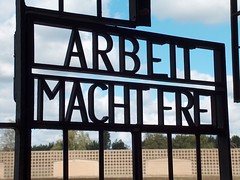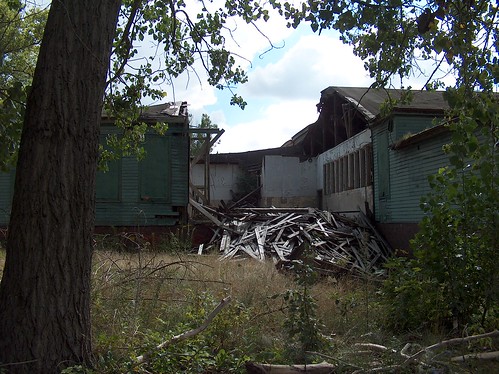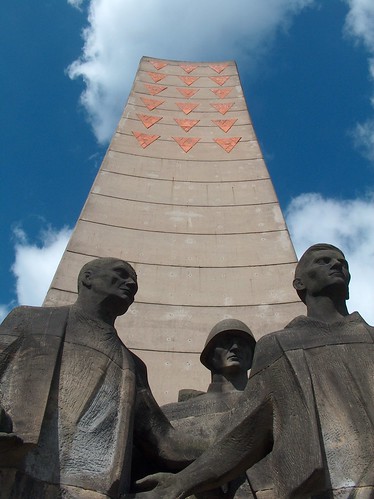Back from Berlin, I suspect that the memory that will endure when all the others have been washed away, is my trip to the Sachsenhausen Concentration Camp some twenty five miles north of the city near the town of Oranienburg. There was so much to learn, so much to read, so many pictures to study and testaments to listen to as well as imbuing the atmosphere of such a vast historical site.

Camp gate - "Work makes you free"
Before the summer of 1933, the area was just pine forest but as the National Socialists identified their perceived enemies, they needed somewhere to put them out of sight and out of mind. And so Sachsenhausen was conceived. At first it gathered in fellow Germans - socialists, communists, dissenters, criminals and these unfortunate men worked under duress to build the vast concentration camp with its many barrack huts, its concrete walls, drains, laundry, infirmary, industrial site, officers' houses, kitchens.
The thing snowballed as the Nazi machine rolled on. The camp became an invaluable training centre for the SS. In 1937, foreign visitors saw the gardens and some clean-shaven orderly prisoners but they didn't see the beatings or the shootings, the hunger, squalor or the unadulterated injustice of the place. Hangings, shootings, kickings increased to a point where ovens were required to reduce hundreds then thousands of human bodies to ash.
Gipsies were exterminated here, Jehovah's Witnesses, homosexuals, religious dissenters, trade unionists, academics and then of course the Jews who were often rolled straight on in to the camp, unloaded and killed with few of the longterm prisoners realising what was going on. Some of the ashes of these poor people were used as road building material. Prisoners with tattoos would often meet death prematurely so that their skin could be used for amusement - sometimes in lampshades.
I saw the mortuary and the evil autopsy slabs near the site of the brothel where specially drafted-in female prisoners were nourished, sometimes sun-lamped, dressed in finery and then systematically abused in a corridor of cell-like rooms. At least one was murdered for becoming pregnant. The most trusted senior prisoners could earn coupons to visit the brothel - it was seen as a way of making them more co-operative and productive.

The decaying remains of the SS officers' wooden mess
In the "New Museum" I saw a photograph from the camp commandant's special collection of an emaciated but very tall prisoner and a dwarf prisoner. For the commandant's amusement, these two men were instructed that they must always be together - at ablutions, on the parade ground, in the barrack room, everywhere, No one knows what happened to these men or indeed who they were or where they were from. They wore numbers like the rest.
In 1961, the East German government held a huge memorial service on the site and a vast column and statue were erected in memory of the 100,00+ who had perished at Sachsenhausen. The site does make the point very firmly that after the second world war, it continued to be a concentration camp run by the Soviet army. They rounded up Nazis, suspected Nazis and sympathisers and for a couple of years things seemed little different from how they had been during the Third Reich. Many died.

The monument erected by the DDR in 1961.
It makes you feel so humble, so grateful, so ashamed, so quiet, so small to visit a place like Sachsenhausen. The evil is still amongst us. It never went away. There under leaden skies which mercifully didn't spill their rain, I may have felt the spirit both of the frightened skeletal men and their jackbooted captors with their warped philosophies and their ice-cold hearts. There is so much else to be said about this grim place but to the hundred thousand gone I say - may you rest in peace and may your deathbells ring out through the centuries ahead as a warning to those who would again take civilisation into darkness.

The outer section where "special" prisoners were housed.







Thanks for that. Beautifully eloquent .
ReplyDeleteBlue skies and little flowers in the grass surrounding places of former atrocities... this is one instance in which color photos drive home the point that humans perpetuate evil upon other humans in the here and now, not just in the "long time ago" of black and white photos.
ReplyDeleteA moving description. What always baffles me is that most of this horror was carried out by 'ordinary' people. No matter how much you tell yourself "I couldn't have done that," it makes you wonder whether we are all capable of such evil, given the right circumstances.
ReplyDeleteI'm reminded of the words of Len Deighton: "To think of Hitler as a deviant or a monster is to miss the point. He was the epitome of the common man."
He may have had a point about the Jovial Witlesses though ;)
very moving.
ReplyDeleteAnd it still goes on. The atrocities commited in the recent wars in the Balkans have a very familiar ring to them.
ReplyDeleteWe surely are the most evil animals on this planet, by far.
One day I hope to visit one of these memorials, if only to see for myself how low the human race will stoop.
And for what?????
I have to confess to being confounded even after a second visit by your (IMHO) obsurantist comment on Dirk's blog. Is he dead or just clapped out from capering with Ms Bug?
ReplyDeleteBe that as it may I've found this post of yours irresistable.
My best friend when I was growing up was the youngest child of a minor functionary at the German embasssy's Australian out-post in Melbourne. I was vaguely aware of my mother's discomfort but was more intersted in my friend than that. Then she went home to Germany and time passed. Eventually she immigrated back to Australia, our friendship blossomed unconstrained and I migrated' to Europe.
My first prolonged holiday was spent touring Germany and the most peculiar sensation overtook me while taking my first train journey out of Frankfurt-am-Main (of all places). It was a sudden and acute (and painful) awareness of how bound up in the worst of Germany's history its fabulous public transport system is.
My best friend for almost forty years is German, I adore Germany (particularly the apple wine of that part of Germany around Frankfurt aM) and I hugely respect the way Germany and its people have confronted the past in order to provide a viable platform for a strong and successful future.
In Germany's case I do believe the palapable sense of history is a positive sign, as evinced by the impact it had on you. Sometimes hope shines in the darkest places.
Thanks for the post.
This subject is difficult for me.
ReplyDeleteWhen I was a teen in San Francisco and discovered the horrors of the Holocaust, I felt as if it were very personal to me. Perhaps I had been a victim in my past life. .. I don't know.